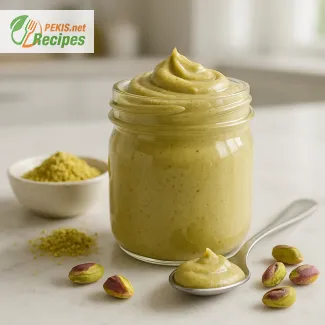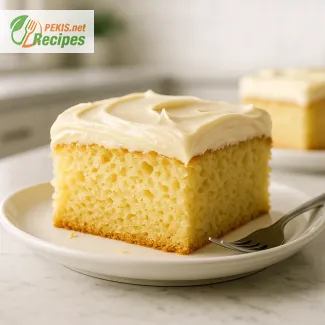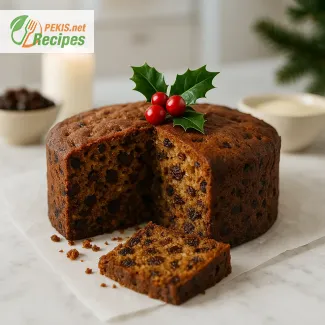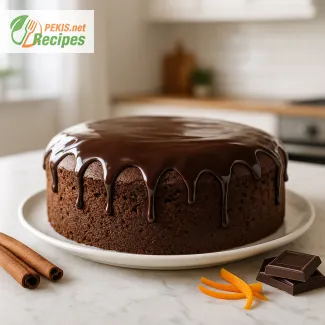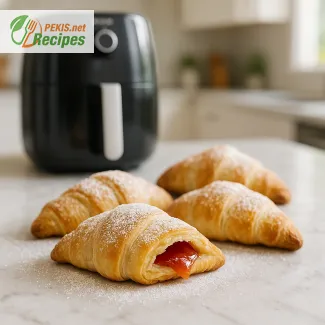
Discover the Unique Charm of Sweden’s Creamy Classic
A beloved Scandinavian dessert with rustic elegance and rich flavor
Among the many treasures of Swedish cuisine, few desserts capture the heart and palate quite like the Swedish Cheesecake, locally known as ostkaka. This traditional dessert is far removed from the dense, overly sweet cheesecakes found elsewhere in the world. Instead, it offers a delicate balance between lightness and richness, subtle sweetness, and a delightful texture that is as comforting as it is sophisticated. Born in the rural heartlands of Sweden, particularly in the province of Småland, Swedish Cheesecake is a recipe steeped in history, family traditions, and a profound respect for natural dairy ingredients.
Unlike the American version, which relies heavily on cream cheese and sugar, Swedish Cheesecake is typically made with fresh curdled milk, eggs, almonds, and just a hint of sweetness. The result is a dish that feels wholesome, homemade, and deeply rooted in Nordic heritage. It is often served warm or room temperature, sometimes accompanied by cloudberry jam, whipped cream, or fresh berries, which add a gentle tartness and vibrant color that beautifully contrast with the creamy base.
A recipe passed through generations
There’s something innately nostalgic about baking a Swedish Cheesecake. The preparation involves simple, rustic techniques that have been passed down for generations in Swedish homes. Traditionally, Swedes would curdle fresh milk with rennet to create their own cheese base. Today, cottage cheese or ricotta often substitutes the homemade curds, maintaining the authenticity while making the recipe accessible to modern kitchens.
This dessert is not just a treat—it’s a story. Each family might add their own twist: a touch of vanilla, a sprinkle of lemon zest, or a specific ratio of almonds to enhance the texture. What remains consistent is the use of honest, humble ingredients that celebrate Sweden’s pastoral traditions and respect for seasonal, high-quality food.
The texture that makes all the difference
One of the most distinctive features of Swedish Cheesecake is its texture. It is neither smooth nor dense but rather slightly grainy, moist, and wonderfully creamy in its own right. The addition of ground almonds and curds provides gentle resistance with every bite, setting it apart from the more uniform textures of commercial cheesecakes. That texture is central to its charm—it feels homemade, crafted by hand, and unmistakably authentic.
This cheesecake doesn’t melt in your mouth the way cream cheese versions do. Instead, it lingers, allowing you to savor each forkful and appreciate the layers of flavor that unfold gradually. The mild tang of dairy, the richness of eggs, and the warmth of almonds all come together in a harmonious, understated dessert that invites you to slow down and indulge mindfully.
Perfect for every season and occasion
Whether served at a midsummer picnic, a winter gathering, or a simple weekend brunch, Swedish Cheesecake adapts to any occasion. Its understated sweetness pairs effortlessly with a variety of toppings, from tart lingonberries and raspberry compote to soft whipped cream or even a drizzle of local honey. That versatility makes it a go-to dessert for Swedes and a delightful discovery for anyone exploring Scandinavian baking for the first time.
Thanks to its rustic presentation and comforting flavor, it also fits beautifully into contemporary culinary trends that favor natural ingredients, traditional techniques, and homemade authenticity. Whether you’re baking for guests or preparing a quiet moment of indulgence for yourself, this cheesecake brings warmth, simplicity, and depth to the table.
Why you’ll love baking Swedish Cheesecake
Preparing this cake is a pleasure in itself. It requires no crust, no water bath, and no overly fussy techniques. It invites a hands-on approach, where textures and aromas guide the process. As it bakes, it fills your kitchen with a rich, toasty scent that promises satisfaction. And once out of the oven, it rests gracefully, ready to be served with a generous spoon of berries and a smile.
This recipe is an ideal introduction to Scandinavian dessert culture—unpretentious yet deeply satisfying. It gives you a taste of Sweden’s farmhouse kitchens, where time slows down, ingredients shine, and desserts are made with care, not shortcuts. If you’re looking for a dessert that feels both comforting and refined, Swedish Cheesecake may become your new favorite tradition.
- Curd preparation: Heat the whole milk in a saucepan over medium heat until it reaches 85°C (185°F). Remove from heat and stir in the vinegar. Let it sit for 10 minutes until the curds form and separate from the whey. Strain through a fine sieve or cheesecloth and let the curds cool completely.
- Batter preparation: In a large bowl, beat the eggs with sugar until light and slightly fluffy. Add in the flour, ground almonds, cottage cheese, and the freshly prepared curds. Mix gently until combined.
- Add melted butter, heavy cream, vanilla extract, salt, and lemon zest (if using). Stir until the batter is smooth and cohesive.
- Bake: Preheat the oven to 175°C (350°F). Grease a 23 cm (9-inch) round baking dish or springform pan. Pour in the batter and smooth the surface. Optionally, sprinkle sliced almonds on top.
- Bake for 50 minutes, or until golden on top and just set in the center. A slight wobble is fine—it will firm up while cooling.
- Let the cake cool to room temperature. Serve slightly warm or chilled, optionally with whipped cream or berry compote.
Elevating Swedish Cheesecake: Creative Tweaks and Modern Touches
Techniques and ingredient upgrades that refine the classic recipe
While Swedish Cheesecake in its traditional form is a culinary gem, there's always room to adapt, personalize, and even enhance a time-honored recipe. Whether you're looking to make the dessert more nutritious, deepen its flavor profile, or simply bring a new twist to the table, small modifications can make a significant impact. The beauty of this cake lies in its simplicity and balance—qualities that can either be subtly amplified or unfortunately compromised depending on your approach.
Improving flavor depth with premium ingredients
One of the easiest ways to elevate the flavor of your Swedish Cheesecake is by upgrading the quality of dairy used. Choosing organic whole milk, farm-fresh eggs, and artisan cottage cheese with minimal processing can drastically enhance the overall taste and texture. The higher butterfat content and richer flavor of these ingredients contribute to a more indulgent mouthfeel and a creamier finish.
For added complexity, you might consider incorporating a hint of citrus zest, like lemon or orange, into the batter. These elements add brightness and balance to the richness of the cream and curds. Alternatively, almond extract—used sparingly—can provide a fragrant nuttiness that complements the ground almonds already in the recipe.
Another enhancement is the use of brown butter instead of regular melted butter. Brown butter introduces nutty, caramelized undertones that lend a deeper, more toasted flavor to the cake, especially effective when combined with almond toppings or served with spiced fruit compote.
Texture tweaks for a more refined result
Texture is one of the defining features of Swedish Cheesecake, and adjusting it can lead to interesting variations. For a smoother, creamier version, blend the cottage cheese and curds thoroughly before adding them to the batter. This creates a consistency closer to a custard while still maintaining the original character of the dish.
If you prefer more bite, increase the quantity of ground almonds or sprinkle in some finely chopped blanched almonds for texture variation. You can also experiment with semolina flour or almond flour as a partial substitute for regular flour to enhance the nuttiness and provide a slightly firmer structure.
Homemade over store-bought: flavor, control, and freshness
Preparing this cheesecake at home offers distinct advantages. First, you gain complete control over sweetness, texture, and ingredient sourcing. Homemade versions are often less sugary, better textured, and free of preservatives or artificial flavorings. You also get the satisfaction of preparing fresh curds, a step that adds authenticity and improves the final product’s depth.
Using homemade curd cheese instead of store-bought cottage cheese also allows you to fine-tune the moisture level. A drier curd will yield a firmer cake, while a wetter one can make the result softer and more custard-like.
Common pitfalls and how to avoid them
Several frequent mistakes can compromise your Swedish Cheesecake. Overbaking is perhaps the most common. A perfect cheesecake should have a light golden crust and a center that still trembles slightly when gently shaken. If it’s too firm or cracked, it’s likely overcooked and may become dry as it cools.
Another error is improper mixing. Overmixing the batter can result in a dense texture, especially if too much air is incorporated. Use a gentle hand to fold in the ingredients, and avoid using high-speed mixers.
Skipping the step of draining the curds well can also lead to a watery cheesecake, which affects both texture and stability. Take the time to allow curds to cool and drain thoroughly before incorporating them into the batter.
Healthier alternatives that don’t sacrifice taste
If you're looking for lighter variations, several substitutions can make your cheesecake more nutritious. Replace heavy cream with Greek yogurt for a lower-fat option that still contributes creaminess and protein. Almond milk or oat milk can replace whole milk, though they will slightly alter the final taste.
Instead of white sugar, consider using maple syrup, honey, or coconut sugar in moderation. These natural sweeteners offer a more complex flavor profile and a gentler impact on blood sugar.
For a gluten-free version, substitute the all-purpose flour with a 1:1 gluten-free flour mix, or use almond flour to keep in line with the nut-based flavor profile.
Seasonal garnishes and serving inspirations
Serving suggestions can also elevate your Swedish Cheesecake experience. While traditional whipped cream and cloudberry jam are delightful, try roasted rhubarb, fig compote, or a drizzle of spiced honey for a modern seasonal twist. During the autumn months, topping the cake with caramelized apples and a dash of cinnamon adds warmth and richness.
In warmer seasons, pair it with fresh raspberries, blueberries, or a herbal berry coulis. Garnishing with edible flowers, light citrus zest, or a dusting of powdered sugar can also enhance presentation without altering flavor.
These adjustments and considerations empower you to make the Swedish Cheesecake truly your own. Whether you're aiming for a healthier dessert, a more intense flavor profile, or simply want to respect tradition while exploring its modern possibilities, each choice brings you closer to a refined, deeply satisfying result.
Allergens and gluten:
- Contains: milk, eggs, almonds, gluten (from flour)
- To make gluten-free: use gluten-free all-purpose flour.
- To make nut-free: omit ground almonds and replace with the same amount of additional flour.
- To make dairy-free: replace milk with soy or almond milk, butter with plant-based margarine, cream with coconut cream, and cottage cheese with dairy-free curd cheese.
- Vitamin A: 180 µg – supports eye health and immune system
- Vitamin D: 1.2 µg – contributes to calcium absorption and bone strength
- Calcium: 180 mg – essential for bone and teeth maintenance
- Iron: 1.1 mg – supports oxygen transport in the blood
- Magnesium: 25 mg – supports nerve function and muscle health
- Potassium: 160 mg – helps regulate fluid balance and muscle contractions
- Vitamin B12: 0.8 µg – important for neurological function and red blood cell formation
- Vitamin E: 1.4 mg – helps protect cells from oxidative stress
- Selenium: 6 µg – supports immune defense and antioxidant function
- Zinc: 1.2 mg – aids immune response and wound healing
